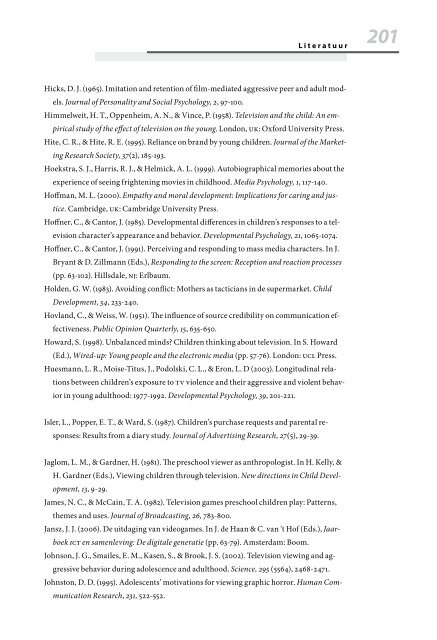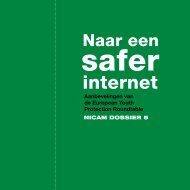Download PDF: Beeldschermkinderen - Kijkwijzer
Download PDF: Beeldschermkinderen - Kijkwijzer
Download PDF: Beeldschermkinderen - Kijkwijzer
Create successful ePaper yourself
Turn your PDF publications into a flip-book with our unique Google optimized e-Paper software.
Literatuur<br />
Hicks, D. J. (1965). Imitation and retention of film-mediated aggressive peer and adult mod-<br />
els. Journal of Personality and Social Psychology, 2, 97-100.<br />
Himmelweit, H. T., Oppenheim, A. N., & Vince, P. (1958). Television and the child: An em-<br />
pirical study of the effect of television on the young. London, UK: Oxford University Press.<br />
Hite, C. R., & Hite, R. E. (1995). Reliance on brand by young children. Journal of the Market-<br />
ing Research Society, 37(2), 185-193.<br />
Hoekstra, S. J., Harris, R. J., & Helmick, A. L. (1999). Autobiographical memories about the<br />
experience of seeing frightening movies in childhood. Media Psychology, 1, 117-140.<br />
Hoffman, M. L. (2000). Empathy and moral development: Implications for caring and jus-<br />
tice. Cambridge, UK: Cambridge University Press.<br />
Hoffner, C., & Cantor, J. (1985). Developmental differences in children’s responses to a tel-<br />
evision character’s appearance and behavior. Developmental Psychology, 21, 1065-1074.<br />
Hoffner, C., & Cantor, J. (1991). Perceiving and responding to mass media characters. In J.<br />
Bryant & D. Zillmann (Eds.), Responding to the screen: Reception and reaction processes<br />
(pp. 63-102). Hillsdale, NJ: Erlbaum.<br />
Holden, G. W. (1983). Avoiding conflict: Mothers as tacticians in de supermarket. Child<br />
Development, 54, 233-240.<br />
Hovland, C., & Weiss, W. (1951). The influence of source credibility on communication ef-<br />
fectiveness. Public Opinion Quarterly, 15, 635-650.<br />
Howard, S. (1998). Unbalanced minds? Children thinking about television. In S. Howard<br />
(Ed.), Wired-up: Young people and the electronic media (pp. 57-76). London: UCL Press.<br />
Huesmann, L. R., Moise-Titus, J., Podolski, C. L., & Eron, L. D (2003). Longitudinal rela-<br />
tions between children’s exposure to TV violence and their aggressive and violent behav-<br />
ior in young adulthood: 1977-1992. Developmental Psychology, 39, 201-221.<br />
Isler, L., Popper, E. T., & Ward, S. (1987). Children’s purchase requests and parental re-<br />
sponses: Results from a diary study. Journal of Advertising Research, 27(5), 29-39.<br />
Jaglom, L. M., & Gardner, H. (1981). The preschool viewer as anthropologist. In H. Kelly, &<br />
H. Gardner (Eds.), Viewing children through television. New directions in Child Devel-<br />
opment, 13, 9-29.<br />
James, N. C., & McCain, T. A. (1982). Television games preschool children play: Patterns,<br />
themes and uses. Journal of Broadcasting, 26, 783-800.<br />
Jansz, J. J. (2006). De uitdaging van videogames. In J. de Haan & C. van ’t Hof (Eds.), Jaar-<br />
boek ICT en samenleving: De digitale generatie (pp. 63-79). Amsterdam: Boom.<br />
Johnson, J. G., Smailes, E. M., Kasen, S., & Brook, J. S. (2002). Television viewing and ag-<br />
gressive behavior during adolescence and adulthood. Science, 295 (5564), 2468-2471.<br />
Johnston, D. D. (1995). Adolescents’ motivations for viewing graphic horror. Human Com-<br />
munication Research, 231, 522-552.<br />
201







